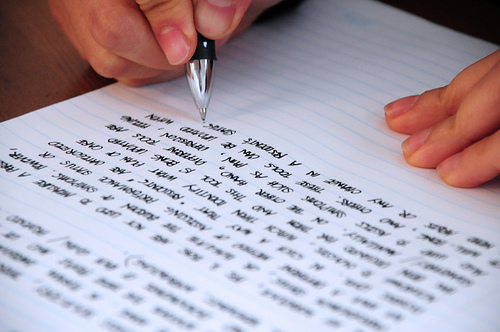There's something poetic about the process of creating a title, isn't there? Like a haiku, the writer must work within a limited space and draw out as much impact as possible.
For me, the title comes at the end of the writing process, after I've had time enough to brainstorm and figure out the purpose of my work. But even then, the process of creating a title does not come naturally to me, and I often end up feeling stuck. When this happens, I try to remember the following tips:
1. Lead the Reader into Your Paper
It's important to cue the reader in on the topic of your essay from the very beginning. To do this, ask yourself the following question: What am I talking about? The answer will provide you with a few key terms that you can use to create a title that situates the reader to your topic.
2. Search-Engine Optimized
If you're writing with the intent to get published, it is beneficial to use terminology in your title that someone might use when searching for articles. Consider which words provided results during your own research. Do these words still apply to the paper you've written? If so, think about how to use them in your title, it's very likely that others will look these same words up in the future.
3. Have a Hook
You want your essay to stand out, don’t you? Try to spice things up with a pun or get creative with wordplay. Having a clever title is an effective way to engage the reader and leave them wanting more. Which of the following would you rather read from:
A). Property Rights in the Elizabethan Era
B). To Deed or Not to Deed: Property Rights in the Elizabethan Era
Although option A is direct, option B compels the reader to keep reading.
4. Do Not Use Automated Title Generators
As a general rule, do not use automatically generated titles. I went to a title generating website and plugged in a few key terms for this blog's title as an experiment. These are the terrible results:
"How to Write Effective Titles: Formulating Frank Rivalry and Alterity," "Estimating Mythical Notions: How to Write Effective Titles and/in the Congress," and "How to Write Effective Titles: Collecting Patronizing Response and Violence."
The only usable segment from these titles is what I plugged in myself, "How to Write Effective Titles..." As you can see, there is absolutely no reason to rely on an automatically generated title. Do Not Use Them!
"How to Write Effective Titles: Formulating Frank Rivalry and Alterity," "Estimating Mythical Notions: How to Write Effective Titles and/in the Congress," and "How to Write Effective Titles: Collecting Patronizing Response and Violence."
The only usable segment from these titles is what I plugged in myself, "How to Write Effective Titles..." As you can see, there is absolutely no reason to rely on an automatically generated title. Do Not Use Them!
The process of writing a title should not be a difficult one. As long as you lead the reader into your essay, use commonly searched terminology, and hook the reader, you'll have a title that reads like poetry.





